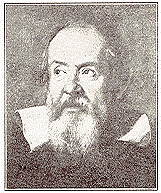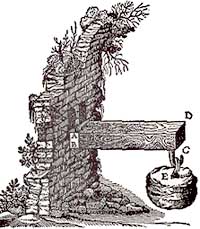Galileo Galilei | 1564-1642
the Birth of Engineering Mechanics

 ithout question one of the greatest minds in history, Domino Galileo Galilei's work is generally considered to be the foundation upon which the science of the Strength of Materials rests. Forced to withdraw from university due to insufficent funds, he never did gain his degree, but was later appointed to the chair of mathematics at Pisa, Padua, and Florence, and made remarkable advances in astronomy, optics and Mechanics. In 1638, he published his book "Two New Sciences," which contains the first publication in the field of strength of materials, and from which the history of the mechanics of elastic materials begins.
ithout question one of the greatest minds in history, Domino Galileo Galilei's work is generally considered to be the foundation upon which the science of the Strength of Materials rests. Forced to withdraw from university due to insufficent funds, he never did gain his degree, but was later appointed to the chair of mathematics at Pisa, Padua, and Florence, and made remarkable advances in astronomy, optics and Mechanics. In 1638, he published his book "Two New Sciences," which contains the first publication in the field of strength of materials, and from which the history of the mechanics of elastic materials begins.
When engineers speak of elastic materials, we are not generally discussing items like rubber bands or underwear waistbands. We say that a material behaves elastically if it deforms (bends, shortens, lengthens, etc.) under some load or force, and, when the force is removed, returns to its original shape. Thus, an elastic band is obviously elastic, but so are timber, steel, and concrete beams. When loaded, they deflect, but return to their unloaded position upon removal of load, provided they do not "fail" under the applied load.

Galileo attempted to determine a method of predicting the strength of elastic timber beams, cantilevered out from a wall, and loaded at the free end, as shown in this diagram from "Two New Sciences." He made an erroneous assumption, however, and predicted a strength three times the actual strength of the beam. Despite this error, he also concluded and set down, for the first time, a number of important observations and conclusions about the behavior of elastic beams. For example, he concluded that a beam becomes "weaker" as its dimensions increase until it finally fails solely under the action of its own weight. From this, he also correctly concluded that there was a natural limit to the size of structures and of living things; he writes "...nor can nature produce trees of extraordinary size because the branches would break down under their own weight; so also it would be impossible to build up the bony structures of men, horses, or other animals so as to hold together and perform their normal functions if these animals were to be increased enormously in height...if the size of a body be diminished, the strength of the body is not diminished in the same proportion; indeed the smaller the body the greater its relative strength. Thus a small dog could probably carry on its back two or three dogs of its own size; but I believe that a horse could not carry even one of its own size..."
It is difficult for us to begin to appreciate the tremendous contributions made by people such as Galileo. Building upon only some sketches and scribblings of Leonardo da Vinci, he essentially formulated a number of the fundamental principles of the strength of materials through observation and deduction, and set them, along with his reasoning, down on paper for others to build on. And build they did. Within a hundred and fifty years, Galileo's postulates had been verified and/or corrected, and the underlying mathematical models that we use today worked out and published.
If you wish to know more about the history of this subject area, and the people who were foremost in its development, you might research the following:
- Mariotte (1620-1684)
- Robert Hooke (1635-1703)
- Jacob Bernoulli (1654-1705)
- Leonard Euler (1707-1783)
- C.A.Coulomb (1736-1806)
- Lagrange (1736-1813)